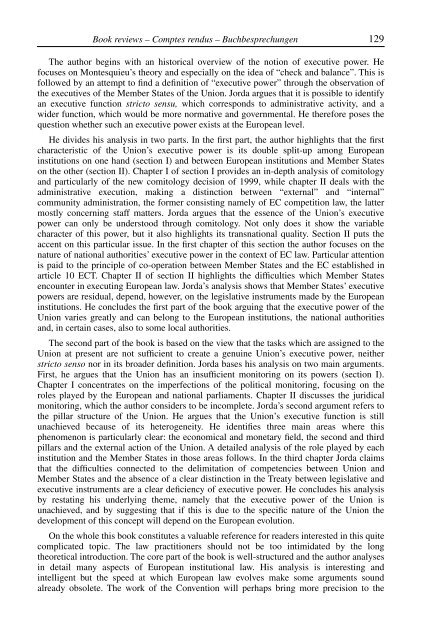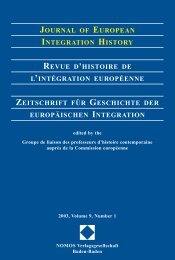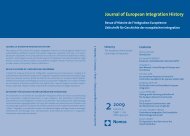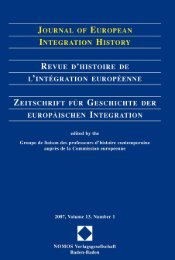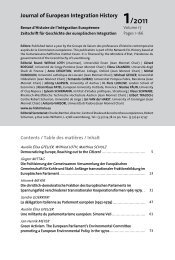journal of european integration history revue d'histoire de l ...
journal of european integration history revue d'histoire de l ...
journal of european integration history revue d'histoire de l ...
Create successful ePaper yourself
Turn your PDF publications into a flip-book with our unique Google optimized e-Paper software.
Book reviews – Comptes rendus – Buchbesprechungen 129The author begins with an historical overview <strong>of</strong> the notion <strong>of</strong> executive power. Hefocuses on Montesquieu’s theory and especially on the i<strong>de</strong>a <strong>of</strong> “check and balance”. This isfollowed by an attempt to find a <strong>de</strong>finition <strong>of</strong> “executive power” through the observation <strong>of</strong>the executives <strong>of</strong> the Member States <strong>of</strong> the Union. Jorda argues that it is possible to i<strong>de</strong>ntifyan executive function stricto sensu, which corresponds to administrative activity, and awi<strong>de</strong>r function, which would be more normative and governmental. He therefore poses thequestion whether such an executive power exists at the European level.He divi<strong>de</strong>s his analysis in two parts. In the first part, the author highlights that the firstcharacteristic <strong>of</strong> the Union’s executive power is its double split-up among Europeaninstitutions on one hand (section I) and between European institutions and Member Stateson the other (section II). Chapter I <strong>of</strong> section I provi<strong>de</strong>s an in-<strong>de</strong>pth analysis <strong>of</strong> comitologyand particularly <strong>of</strong> the new comitology <strong>de</strong>cision <strong>of</strong> 1999, while chapter II <strong>de</strong>als with theadministrative execution, making a distinction between “external” and “internal”community administration, the former consisting namely <strong>of</strong> EC competition law, the lattermostly concerning staff matters. Jorda argues that the essence <strong>of</strong> the Union’s executivepower can only be un<strong>de</strong>rstood through comitology. Not only does it show the variablecharacter <strong>of</strong> this power, but it also highlights its transnational quality. Section II puts theaccent on this particular issue. In the first chapter <strong>of</strong> this section the author focuses on thenature <strong>of</strong> national authorities’ executive power in the context <strong>of</strong> EC law. Particular attentionis paid to the principle <strong>of</strong> co-operation between Member States and the EC established inarticle 10 ECT. Chapter II <strong>of</strong> section II highlights the difficulties which Member Statesencounter in executing European law. Jorda’s analysis shows that Member States’ executivepowers are residual, <strong>de</strong>pend, however, on the legislative instruments ma<strong>de</strong> by the Europeaninstitutions. He conclu<strong>de</strong>s the first part <strong>of</strong> the book arguing that the executive power <strong>of</strong> theUnion varies greatly and can belong to the European institutions, the national authoritiesand, in certain cases, also to some local authorities.The second part <strong>of</strong> the book is based on the view that the tasks which are assigned to theUnion at present are not sufficient to create a genuine Union’s executive power, neitherstricto senso nor in its broa<strong>de</strong>r <strong>de</strong>finition. Jorda bases his analysis on two main arguments.First, he argues that the Union has an insufficient monitoring on its powers (section I).Chapter I concentrates on the imperfections <strong>of</strong> the political monitoring, focusing on theroles played by the European and national parliaments. Chapter II discusses the juridicalmonitoring, which the author consi<strong>de</strong>rs to be incomplete. Jorda’s second argument refers tothe pillar structure <strong>of</strong> the Union. He argues that the Union’s executive function is stillunachieved because <strong>of</strong> its heterogeneity. He i<strong>de</strong>ntifies three main areas where thisphenomenon is particularly clear: the economical and monetary field, the second and thirdpillars and the external action <strong>of</strong> the Union. A <strong>de</strong>tailed analysis <strong>of</strong> the role played by eachinstitution and the Member States in those areas follows. In the third chapter Jorda claimsthat the difficulties connected to the <strong>de</strong>limitation <strong>of</strong> competencies between Union andMember States and the absence <strong>of</strong> a clear distinction in the Treaty between legislative an<strong>de</strong>xecutive instruments are a clear <strong>de</strong>ficiency <strong>of</strong> executive power. He conclu<strong>de</strong>s his analysisby restating his un<strong>de</strong>rlying theme, namely that the executive power <strong>of</strong> the Union isunachieved, and by suggesting that if this is due to the specific nature <strong>of</strong> the Union the<strong>de</strong>velopment <strong>of</strong> this concept will <strong>de</strong>pend on the European evolution.On the whole this book constitutes a valuable reference for rea<strong>de</strong>rs interested in this quitecomplicated topic. The law practitioners should not be too intimidated by the longtheoretical introduction. The core part <strong>of</strong> the book is well-structured and the author analysesin <strong>de</strong>tail many aspects <strong>of</strong> European institutional law. His analysis is interesting andintelligent but the speed at which European law evolves make some arguments soundalready obsolete. The work <strong>of</strong> the Convention will perhaps bring more precision to the


